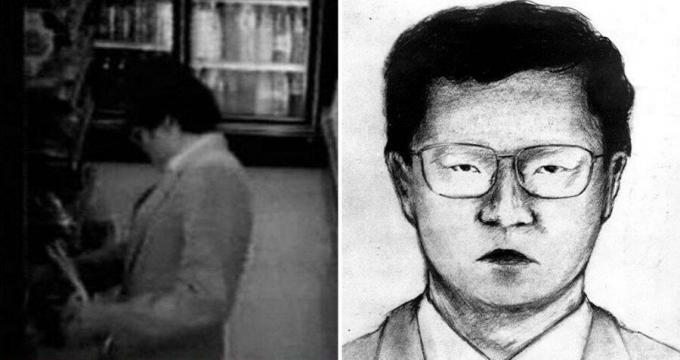Do you know the story of the Monster with 21 Faces? He was a criminal who terrorized Japan in the 1980s through blackmail letters and poisoned sweets. Do you know what the most macabre part of this story is? The police never found a culprit for the crimes.
The story involves burning cars, falling candy sales and a generalized panic in the Asian country.
see more
These are the 4 zodiac signs that love solitude the most, according to…
There are some dog breeds considered perfect for people…
Let's start from the beginning?
Let's go!
In March 1984, Katsuhisa Ezaki, CEO of food manufacturer Ezaki Glico, was kidnapped. Criminals demanded a ransom of 1 billion yen (about R$ 20.2 million in current exchange rate) and 100 kg of gold bars. The businessman managed to escape due to an oversight by the kidnappers, but that was the beginning of a wave of terror all over japan.

Photo: Katsuhisa Ezaki
It all started a month later. On April 10 of that year, Glico cars were set on fire in the company's own parking lot. This caused the police to intensify investigations, as they deduced that the crimes were interconnected.
Confirmation came a month later. On May 10th, a threatening letter signed by the Monster with 21 Faces (Kaijin Nijyu-Mensou) arrived at the company. It is important to note that this is the name of a crime novel by writer Edogawa Rampo.
In the letter, the criminal claimed that some Glico sweets had been mixed with potassium cyanide, which caused widespread panic. In view of this, the police decided to remove all the company's products from supermarkets in Japan.
Needless to say, the result of this was a deficit of almost BRL 96 million and a massive layoff of 400 employees.
And the police did nothing?
So, the police were like in that song by the singer Luka: “hands tied, feet bare”. That's because they had very few clues.
The researchers only had images of a security camera in a store. In these, a man who was not a Glico employee placed some of the company's sweets on the shelves. As the man wore a baseball cap and the images were not as sharp as they are today, the police investigation did not advance.

In addition, some information was missing. It was known that two men kidnapped Ezaki, but the number of people who set the cars on fire was clearly higher. Also, only one person was seen handling the company's sweets.
So investigators weren't quite sure how many people they were looking for.
Cards from the Monster with 21 Faces proposed truce
“Dear police officers, do not lie. Every crime starts with a lie, as we say in Japan. Don't you know that? They seem to be lost”, said one of the letters signed by the Monster of 21 Faces, whose texts started to become more threatening.
By mid-June 1984, candy sales had plummeted and panic gripped the population.
That month, the criminal tried to make a truce with the police. He proposed to cease his shares in exchange for 50 million yen (approximately R$ 1.7 million), but he made some demands: the money should be dropped from a moving train in the city of Kyoto.
Undercover officers were on this train and noticed only one passenger who "acted strangely" and had "fox eyes". However, he managed to lose the agents. Nothing happened that day, nor in another delivery attempt that took place months later.
more victims
As of October, the criminal intensified his actions. The Monster of 21 Faces began to pursue other Japanese companies, including Marudai and Morinaga. He sent a letter to the press, warning mothers that 21 packets of candy from these factories contained cyanide.
This time, the police managed to identify the packages and withdrew them from the market. Detail: the contaminated products had “caution, toxic” on their packaging.
And who is the Monster with 21 Faces?
In 1985, the police finally got a sketch based on the security footage mentioned at the beginning of the story. However, they did not obtain any identification.

With a lot of effort, investigators arrived at Miyazaki Manubu in Tokyo. He was an activist who exposed Glico for dumping industrial waste into Osaka rivers in 1975. The police found a tape with the man's voice and, in the audio, he pronounced words similar to those of the Monster of 21 Faces.
However, it was weak evidence and the man had an airtight alibi.
final act
The investigation ended tragically with the suicide of Shiga Police Chief Shoji Yamamoto. So, the Monster with 21 Faces wrote his last letter to the police.
“Shoji Yamamoto died. What a stupid attitude! We have no friends or secret hiding places. What have the police been doing for the past year and five months?” he wrote. “Don't let criminals like us get away. We decided to stop badgering food companies. If anyone tries to blackmail them, it won't be us, but someone trying to copy us. We are bad people. This means we can do more than just go after these companies. It's fun to lead the life of a bad man.”
The case was closed in 2000 and, to this day, the true identity of the Monster with 21 Faces is unknown.
Graduated in Social Communication at the Federal University of Goiás. Passionate about digital media, pop culture, technology, politics and psychoanalysis.



